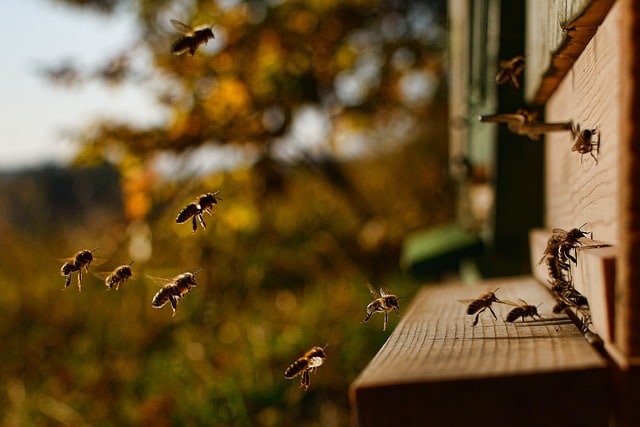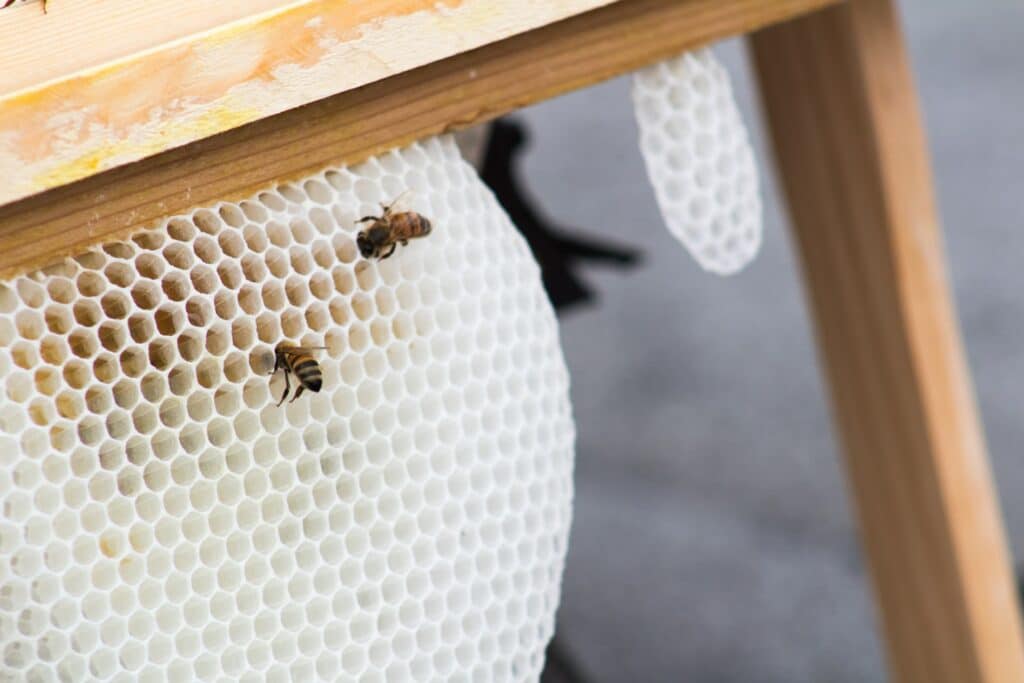Introduction – Bees As Pollinators
ShrinkThatFootprint has covered beeswax, honey, and other sustainable products before. In fact bees make a number of products. Today we’ll talk about all the products that come from bees. First and foremost, bees are best known for their role as pollinators, as they are responsible for the fertilization of many plants and crops. However, bees also produce a number of products that are used by humans, including honey, beeswax, and propolis.

The Most Common Bee Used By Humans – Apis mellifera, The Western Honey Bee
There are many different species of bees that are used by humans, including honey bees, bumblebees, and solitary bees. However, the most commonly used bee for the production of honey and other bee products is the Western honey bee (Apis mellifera), which is found throughout Europe, Asia, and Africa.
In addition to honey bees, other species of bees that are used by humans include bumblebees and solitary bees. Bumblebees are larger than honey bees and are characterized by their fuzzy appearance and their ability to buzz-pollinate, which is a type of pollination that is necessary for some plants to produce fruit. Solitary bees are not social insects, and do not live in colonies like honey bees and bumblebees do. Instead, they live and reproduce individually, and are known for their efficiency as pollinators.
Overall, there are many different species of bees that are used by humans, and the specific species that are used can vary depending on the location and the specific needs of the beekeeper.
Bees Make Useful Stuff – Products Made By Bees
Bees are important to humans for their role as pollinators, as they are responsible for the fertilization of many crops and plants that are important to human agriculture. In addition, bees also produce a number of products that are used by humans, including honey, beeswax, and propolis.
Product #1: Honey
By far the most commonly used product of bees is Honey. Honey is a sweet, thick liquid that is produced by bees from the nectar of flowers. It is commonly used as a sweetener in food and beverages, and has also been used medicinally for thousands of years.
In terms of its use as a sweetener, honey is commonly used as a substitute for sugar in a variety of foods and drinks. It has a distinctive flavor that is different from sugar, and is often used to add sweetness and depth of flavor to baked goods, beverages, and other foods. Honey is also a popular sweetener for tea, as it dissolves easily in hot water and has a soothing, calming effect.
In addition to its use as a sweetener, honey is also used for its medicinal properties. It has been used as a natural remedy for a variety of ailments, including coughs, colds, and sore throats. Honey is also believed to have antioxidant and anti-inflammatory properties, which may make it useful in the treatment of certain conditions, such as heart disease and cancer.
Product #2: Beeswax

Beeswax is a natural, honey-colored wax that is produced by bees to build the honeycomb structures in their hives. It is a versatile material that is used in a variety of products, including candles, cosmetics, and polishes. In fact, they are a great source of renewable wax for eco-friendly and zero waste candles.
One of the most common uses for beeswax is in the production of candles. Beeswax candles are considered to be superior to candles made from other materials, such as paraffin wax, because they burn cleanly and produce a bright, natural light. Beeswax candles are also long-lasting and slow-burning, making them a more economical option than other types of candles.
Beeswax is also used in the production of cosmetics and personal care products, such as lip balms, creams, and lotions. It is valued for its emollient properties, which help to moisturize and protect the skin, and for its natural scent, which is often described as honey-like. Beeswax is also used in the production of polishes, as it has a natural ability to repel water and dirt, making it useful for protecting and preserving a variety of surfaces.
For some of our readers who are vegan, using beeswax-containing lip balm is a no-no. In this situation, a specific vegan lip balm would be the correct substitute.
Product #3: Propolis
Propolis is a sticky, resinous substance that is produced by bees from tree sap and other plant materials. It is used by bees to seal gaps and cracks in their hives, and has been used medicinally by humans for its antibiotic and anti-inflammatory properties.
Propolis is commonly used as a natural remedy for a variety of ailments, including colds, coughs, and sore throats. It is believed to have antiviral and antibacterial properties, which may make it effective in the treatment of these conditions. Propolis is also used as a natural pain reliever, and is often included in ointments and creams that are used to relieve muscle and joint pain.
In addition to its medicinal uses, propolis is also used in the production of a variety of products, including cosmetics, dental care products, and food. It is used in cosmetics for its moisturizing and protective properties, and is often included in lip balms, creams, and lotions.
In dental care products, propolis is used for its antibacterial properties, and is often included in mouthwashes and toothpastes. In food, propolis is used as a natural preservative, and is often included in products such as honey and candy.
Product #4: Royal Jelly (Only For Bees)
In addition to these products, bees also produce royal jelly, which is a milky substance that is fed to the queen bee, and bee pollen, which is a powdery substance that is collected by bees from flowers and is used as a dietary supplement.
Royal jelly is not commonly used by humans. Among its rare uses are as an ingredient in traditional medicine for its potential health benefits. It is believed to have anti-inflammatory, antioxidant, and immune-boosting properties, and has been used to treat a variety of conditions, including asthma, allergies, and skin conditions.
Product #5: Bee Venom
Bee venom is used to treat bee sting allergies. The way that it works is by introducing a small amount of venom into the body in order to build up a tolerance in the body, which should reduce the severity of future allergic reactions. Bee venom has also been studied for its possible anti-inflammatory and analgesic effects. There are also purported medical uses but there’s not much evidence to support them.
There Are 20,000 Species Of Bees
Bees are a type of insect that belongs to the family Apidae. There are more than 20,000 known species of bees, which can be found on every continent except Antarctica. Bees are best known for their role as pollinators, as they are responsible for the fertilization of many plants and crops. They accomplish this by collecting nectar and pollen from flowers and transferring it from one flower to another as they move from place to place.
Bees have a number of physical characteristics that are adapted to their role as pollinators. These include long, hair-covered bodies that are covered in tiny scales, which help to collect and distribute pollen, and a pair of wings that allow them to fly from flower to flower. Bees also have a long proboscis, which is a straw-like mouthpart that they use to suck up nectar from flowers.
Bees live in colonies, which are organized social structures that are made up of a queen bee, drones (male bees), and worker bees (sterile female bees). The queen bee is the largest and longest-lived member of the colony, and is responsible for laying eggs and producing the pheromones that help to maintain the social structure of the colony.
The drones are responsible for mating with new queens, while the worker bees are responsible for foraging for food, caring for the young, and maintaining the hive.
Honeybee Decline – Should We Be Worried

Honeybee decline is a fairly recent phenomenon in which the number of honeybees in a particular area decreases significantly over time. This is a problem that affects the entire ecosystem, as honeybees are responsible for pollinating many food crops, such as apples, almonds, and blueberries.
The decline of honeybee populations is largely attributed to a variety of factors, including parasites and diseases, climate change, and the use of certain pesticides. In addition, the destruction of natural habitats and the shortage of forage for bees are also contributing factors.
To address this issue, conservationists have proposed numerous strategies, such as creating bee-friendly habitats, introducing habitat corridors, and reducing pesticide use. Additionally, research is ongoing to better understand the causes of honeybee decline and to find ways to protect the species from further decline.
Conclusions – Products Made By Bees
Overall, bees produce a number of products that are valued for their flavor, nutritional value, and potential health benefits.
